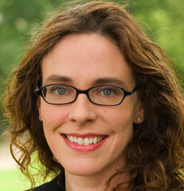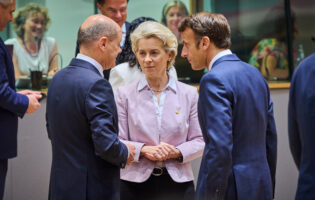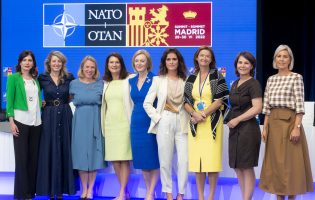German Unification and European Security

Mary Elise Sarotte
Johns Hopkins School for Advanced International Studies
An expert in the history of international relations, Mary Elise Sarotte is the inaugural holder of the Marie-Josée and Henry R. Kravis Distinguished Professorship of Historical Studies at Johns Hopkins School for Advanced International Studies (SAIS). Sarotte is also a research associate at Harvard University's Center for European Studies. Sarotte earned her AB in History and Science at Harvard and her PhD in History at Yale University. She is the author or editor of five books, including The Collapse: The Accidental Opening of the Berlin Wall and 1989: The Struggle to Create Post-Cold War Europe, both of which were selected as Financial Times Books of the Year, among other awards. Following graduate school, Sarotte served as a White House Fellow, then joined the faculty of the University of Cambridge, where she received tenure before accepting an offer to return to the United States to teach at USC. Sarotte is a former Humboldt Scholar, a former member of the Institute for Advanced Study in Princeton, and a member of the Council on Foreign Relations.
AGI is pleased to present this collection of essays reflecting on the 25th anniversary of German unification in October 2015. We are grateful to those who have contributed to this collection, all of whom have been affiliated with and supported the Institute in many different capacities. These essays leave us with thoughts not only about the past, but also about the future of German-American relations. Be sure to check back throughout the week for additional insights.
How has German unity impacted the U.S. in terms of its policies and its expectations of Germany as part of that evolving Europe in which it has become so critically important? How have the following years impacted the shaping of U.S. foreign policy, its goals, and its application? What expectations emerged about the global role of the U.S. and our expectations of a unified Germany?
The questions above are the ones on which AGI has asked commentators in this series to reflect upon as the 25th anniversary of the unification of Germany approaches on October 3. They are all significant questions but, given the space constraints, I would like to limit this brief comment to one particular aspect on which I have some modest expertise: the extensive overlap between the process that yielded German unification and the process that yielded expansion of the North Atlantic Treaty Organization (NATO).
I have published the historical details of this overlap in numerous places. (A quick search online will lead to those publications and to the endnotes identifying the archival sources on which my arguments are based.) Here, allow me to provide a summary overview of my argument. Put briefly, it is not a coincidence that, after the reunification of Germany in 1990, NATO expanded into former East German territory and, subsequently, twelve Central and Eastern European countries as well.
To summarize the evidence now available on this topic: leaders on both sides of the Atlantic realized in late 1989 and early 1990 that the fall of the Berlin Wall created a great deal of uncertainty about the future shape of European security. President George H.W. Bush felt strongly that, in the face of this uncertainty, the transatlantic alliance should maintain its leadership role in the post-Cold War era. He also felt that the continued presence of NATO’s troops in Europe necessarily meant that of their nuclear weapons as well. The alliance and its arsenal was, in Bush’s view, the “only organization” that could ensure European security.
In contrast, some European leaders at the time—such as the French president, François Mitterrand, and the Soviet leader, Mikhail Gorbachev—felt that the opportunity provided by the end of the Cold War should be seized as a means of overcoming long-standing European divisions. They called for a kind of pan-Europeanism to become the guiding principle in the construction of a “common European home” and of a comprehensive European security system. Such a vision included not only Central and Eastern Europe but also, potentially, the Soviet Union as well. This concept meant a potential reduction (though not elimination) of the role played by the U.S.
This pan-European vision never became a detailed plan, however. It soon lost out to the skillful diplomacy of Washington and Bonn. As a counterfactual, though, it helps us to recognize the nature of the actual international order that emerged from the contest of 1990 by contrast with what did not emerge. Pan-Europeanism did not succeed in the contest over the future of European security after the dramatic upheavals of 1989. Instead, the pre-eminent Cold War security organization, NATO, handily survived the contest over the future of European security.
The legacy of that contest represents a significant component of the Russian challenge to international order today. The result of 1990 was the perpetuation of the pre-eminent Cold War military organization, which enabled its later expansion. This result had the support of voters and elected leaders from Washington to Central and Eastern Europe. And, contrary to Russian claims, there were no written accords that forbid subsequent NATO expansion. (Spoken remarks in high-level interactions told a different story, as I have detailed elsewhere, but were ultimately not formalized in a binding fashion).
The perpetuation of NATO solved the pressing issue of the future of European security at a time when it was very much a source of concern. But, American claims to the contrary notwithstanding, it was not a perfect strategy. This strategy also perpetuated other aspects of the Cold War—such as a dividing line between NATO and non-NATO Europe—into the post-Cold War era as well. The persistence of these Cold War configurations has taken on new significance since Putin’s resentment of them emerged in newly violent form in 2008 and, more notably, in 2014. By understanding what was set in motion 25 years ago this fall, we can better understand the crisis on our hands in the present day.
Dr. Mary Sarotte is a Professor of International Relations and History and Dean’s Professor of History at the University of Southern California. She is the recipient of AGI’s 2009 DAAD Prize in German and European Studies.








